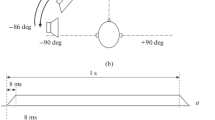Abstract
The precedence effect is a phenomenon characterizing the noise stability of the auditory system in localizing a sound source. This phenomenon is based on the ability of the auditory system to localize a direct sound in an environment of masking acoustic reflections coming from various surfaces. To create the precedence effect, we used two signals: the first was a direct signal (the lead) and the second one arriving at a delay relative to the onset of the lead was an echo signal (the lag). The signals were presented in the horizontal plane. Their duration was 1 s. Delays between the onset of the lag and that of the lead ranged from 1 to 40 ms. The suppression of the moving lag was compared in the study with that of the stationary lag. The movement of the lag was created along two paths located to the left from the subject’s head midline in the horizontal plane (–86°...–52° and –52°...–18°). The stationary lag was located at the ends of these two paths. The lag movement was simulated in opposite directions (either approaching or distancing from the lead signal). The lead was always stationary and located to the right from the head midline in the horizontal plane (15°). The lag suppression was estimated by echo suppression threshold values. It has been shown for the stationary lag that the nearer the lag was located to the lead the higher the lag was suppressed and the mean echo suppression threshold values increased from 5.1 to 7.1 ms. The location and the direction of movement of a travelling lag did not affect its suppression. The mean threshold values ranged from 6.2 to 6.9 ms. Individual differences between the threshold values were greater with moving signals than with stationary ones.





Similar content being viewed by others
REFERENCES
Blauert, J., Räumliches Hören, Stuttgart: Hirzel Verlag, 1974.
Zurek, P.M., The precedence effect, in Directional Hearing, Yost, W.A. and Gourevitch, G., Eds., New York: Springer-Verlag, 1987, p. 85.
Brown, A.D., Stecker, G.C., and Tollin, D.J., The precedence effect in sound localization, J. Assoc. Res. Otolaryngol., 2015, vol. 16, no. 1, p. 1.
Brown, A.D. and Stecker, G.C., Temporal weighting of interaural time and level differences in high rate click trains, J. Acoust. Soc. Am., 2010, vol. 128, no. 1, p. 332.
Schnupp, J., Nelken, I., and King, A., Auditory Neuroscience, Cambridge, Ma: MIT Press, 2010, p. 177.
Litovsky, R.Y., Colburn, H.S., Yost, W.A., and Guzman, S.J., The precedence effect, J. Acoust. Soc. Am., 1999, vol. 106, p. 1633.
Litovsky, R.Y. and Shinn-Cunningam, B.G., Investigation of the relationship among three common measure of precedence: fusion, localization dominance, and discrimination suppression, J. Acoust. Soc. Am., 2001, vol. 109, p. 346.
Yang, X. and Grantham, D.W., Echo suppression and discrimination suppression aspects of the precedence effect, Percept. Psychophysiol., 1997, vol. 59, p. 1108.
Shinn-Cunningham, B.G., Zurek, P.M., and Durlach, N.I., Adjustment and discrimination measurememts of the precedence effect, J. Acoust. Soc. Am., 1993, vol. 93, p. 2923.
Al’tman, Ya.A., Romanov, V.P., and Shakhshaev, S.A., Specific binaural release from masking during auditory image motion, Fiziol. Chel., 1982, vol. 8, p. 537.
Agaeva, M.Yu., The precedence effect and a moving signal, Sens. Sist., 2010, vol. 24, no. 4, p. 227.
Bardin, K.V., Problema porogov chuvstvitel’nosti i psikhofizicheskie metody (The Problem of Sensitivity Thresholds and Psychophysical Methods), Moscow: Nauka, 1976, p. 170.
Agaeva, M.Yu., The precedence effect in the horizontal and vertical planes in experiments with a moving lagging signal, Hum. Physiol., 2011, vol. 37, no. 5, p. 545.
Zurek, P.M., The precedence effect and its possible role in the avoidance of interaural ambiguities, J. Acoust. Soc. Am., 1980, vol. 67, p. 952.
Cliffton, R.F., Freyman, R.L., Litovsky, R.Y., and McCall, D.D., Listeners’ expectation about echoes can raise or lower echo threshold, J. Acoust. Soc. Am., 1994, vol. 95, no. 2, p. 874.
Litovsky, R.Y. and Godar, S.P., Difference in precedence effect between children and adults signifies development of sound localization abilities in complex listening tasks, J. Acoust. Soc. Am., 2010, vol. 128, no. 4, p. 1979.
Devore, S., Ihlefeld, A., Hancock, K., et al., Accurate sound localization in reverberant environments is mediated by robust encoding of spatial cues in the auditory midbrain, Neuron, 2009, vol. 62, p. 123.
Lorenzi, C., Gatehouse, S., and Lever, C., Sound localization in noise in normal-hearing listeners, J. Acoust. Soc. Am., 1999, vol. 105, p. 1810.
Gai, Y., Ruhland, J.L., and Yin, T.C.T., Effect of forward masking on sound localization in cats: basic findings with broadband maskers, J. Neurophysiol., 2013, vol. 110, p. 1660.
Al’tman, Ya.A., Prostranstvennyi slukh (Spatial Hearing), St. Petersburg: Inst. Fiziol. im. I. P. Pavlova, Ross. Akad. Nauk, 2011.
Middlebrooks, J.C. and Green, D.M., Sound localization by human listeners, Annu. Rev. Psychol., 1991, vol. 42, p. 135.
Agaeva, M.Yu. and Al’tman, Ya.A., Differential velocity thresholds for an auditory target moving in the vertical plane, Acoust. Phys., 2004, vol. 50, no. 3, p. 278.
Shestopalova, L.B., Petropavlovskaia, E.A., Vaitulevich, S.P., and Nikitin, N.I., Sensitivity of the hearing system to the velocity of auditory motion: discrimination thresholds and mismatch negativity, Hum. Physiol., 2015, vol. 41, no. 2, p. 123.
Carlile, S. and Leung, J., The perception of auditory motion, Trends Hear., 2016, vol. 20, p. 1.
Author information
Authors and Affiliations
Corresponding author
Additional information
Translated by N. Tarasyuk
Rights and permissions
About this article
Cite this article
Agaeva, M.Y. Influence of the Location of Moving and Stationary Lags on Their Suppression. Hum Physiol 44, 647–655 (2018). https://doi.org/10.1134/S0362119718060026
Received:
Published:
Issue Date:
DOI: https://doi.org/10.1134/S0362119718060026




